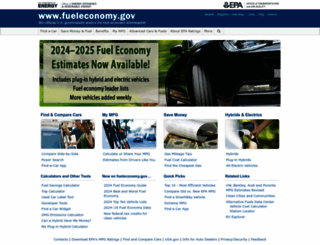Fuel Economy
Page Load Speed
15.7 sec in total
First Response
564 ms
Resources Loaded
8.5 sec
Page Rendered
6.6 sec

About Website
Visit fueleconomy.gov now to see the best up-to-date Fuel Economy content for United States and also check out these interesting facts you probably never knew about fueleconomy.gov
EPA gas mileage, safety, air pollution, and greenhouse gas estimates for new and used cars and trucks. Improve the MPG of your vehicle with our gas mileage tips.
Visit fueleconomy.govKey Findings
We analyzed Fueleconomy.gov page load time and found that the first response time was 564 ms and then it took 15.2 sec to load all DOM resources and completely render a web page. This is a poor result, as 90% of websites can load faster.